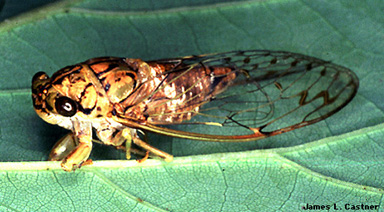Cicada
Natural History

Adult cicada
Photo credit: James L. Castner
Cicadas are found throughout the eastern Unites States but are not considered major forest pests in Florida. There are many species of cicadas, the most famous of which are the periodical cicadas in the genus Magicicada that spend either 13 or 17 years underground before emerging at the same time in large numbers. Florida does not have any species of Magicicada, but it does have several other types of cicada.
When female cicadas lay eggs, they do so by cutting a slit into tree twigs with a saw-like, egg-laying apparatus. Twigs are often splintered by the laying of the eggs and these twigs can die. Only young trees are in real danger of being severely harmed.
The eggs in the tree twigs hatch and the young, immature cicadas, which are in what is called the nymph stage, fall from the twigs and burrow into the soil. The nymph feeds on tree roots for many years (2 to 17 years depending on the species), while it gradually matures. Eventually the more mature nymph emerges from the soil, crawl up along vertical objects like tree trunks, and the nymphal skin splits open to release the mature, winged adult. The adults generally do not feed on trees. They mate and the female lays eggs in tree shoots to start the cycle again. The male cicadas make a shrill, nearly continuous sound that is used as a mating call.
One of the interesting things about cicadas is that they are attacked by a specialized group of large, fearsome-looking wasps called "cicada killers." When the female cicada killer wasp catches a live cicada, she paralyzes it with a sting and then carries it to her burrow and buries it underground (alive) as food for her young:
"After putting one or more cicadas in her nest cell, the female deposits an egg on a cicada and closes the cell with dirt. Male eggs are laid on a single cicada but female eggs are given two or sometimes three cicadas; this is because the female wasp is twice as large as the male and must have more food. New nest cells are dug as necessary off of the main burrow tunnel and a single burrow may eventually have 10 or more nest cells. The egg hatches in one or two days, and the cicadas serve as food for the grub."
- Wikipedia: Sphecius speciosus (retrieved: 27 February 2014)
